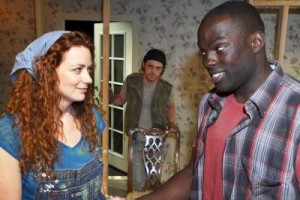
Ronan Noone’s The Blowin Of Baile Gall deals with racism and xenophobia in Ireland, but it could just as easily be set anyplace in the United States where people frustrated with their own failures and inadequacies find it necessary to stereotype and demonize those who are “the other.” It could be about African Americans angry at Korean grocers taking over businesses in “their” neighborhoods, or Latinos detesting the gentrification of their neighborhoods by upscale gays, or Caucasians complaining about “illegal immigrants.” Sound familiar?
In Irish slang, a “blowin” is an outsider, and in Roone’s play there are three, each of whom finds himself the object of day laborer Eamon Collins, Jr.’s wrath.
If Eamon’s life had gone the way he’d wished, there would probably be no need for him to hate those who are different, but Eamon is consumed with hatred and resentments. Others may have benefited from better economic and educational opportunities in Ireland, but not Eamon, who’s not only on the dole but doing menial (and, as a welfare recipient, illegal) construction work. Making matters worse, the house he’s now renovating used to be his family home, but has been purchased by a British couple, a fact that fills Eamon with impotent rage.
The blowin of Baile Gall (at least in Eamon’s eyes) are:
1) Fellow laborer (and Eamon’s best bud) Stephen O’Gorman, a scrappy lad who used to be “Wild Stevie” before joining AA and becoming a born again Christian. Though Stephen has spent most of his life in Baile Gall, initially in an orphanage, he was born elsewhere, thus preventing him from ever becoming anything other than a blowin. Eamon’s friendship with Stephen is threatened by Stephen’s romantic relationship with Molly Black, Eamon’s ex-girlfriend and by his new-found sobriety/piety which most definitely rubs Eamon the wrong way.
2) Samuel Carson Jr., aka “Yank,” aka the G.C. (general contractor) of the renovation. Carson left Baile Gall twenty years ago for America, and has recently returned to his hometown with his American wife. Eamon resents Carson’s success, a resentment made even more bitter by the fact that Eamon’s mother had lost her shop to the G.C.’s father.
3) Lawrence aka Lionel, a Black African “fugee” (refugee) who has left a homeland ravaged by violence only to find himself the most hated blowin of all. All Lawrence wants to do is his job, however menial the pay is, in hopes of bringing his mother to Ireland, but all Eamon can see is that a blowin was hired for a job instead of a local like Eamon’s cousin.
Completing the cast of characters is the aforementioned Molly, who however young and beautiful she may seem to the American eye, is rapidly approaching the age in which the citizens of Baile Gall will call her a spinster, i.e. without any hope of finding a husband and starting a family.
The only way Eamon can deal with his own failures is by attempting to destroy whatever successes or happiness those more fortunate than he have found. Thus, like an Irish Iago, Eamon begins planting seeds of doubt in Stephen’s head, leading him to believe that Molly is contemplating an affair with Lawrence. Eamon also does his best to sabotage his friend’s sobriety, as well as that of the G.C., who also attends AA meetings. And that’s only the beginning.
The Blowin of Baile Gall is powerful stuff, and in the hands of an impeccable cast and director, there is nothing to quibble about in its execution at the Lyric Theatre except for it 2 ½ hour running time. Were it about 30 minutes less, The Blowin would be even stronger stuff. 150 minutes of seething hatred and resentment is a bit much to sit through (thank goodness for the intermission), especially with a performance as strong as Tim Hamelen’s as Eamon.
Hamelon shows us again and again Eamon’s unrelenting anger, and though the actor lets us occasionally glimpse the happy and even charming man Eamon might have been had things been different in his life, when we look into his eyes, we see racism and xenophobia’s ugly face personified, and it’s not a pretty picture.
The actor is matched by the electric performance of Dan O’Brien as Stephen. O’Brien reveals the fires boiling under Stephen’s surface which the young Irishman attempts to bury in the pages of the Bible he reads incessantly. Also, despite his new-found sobriety and piety, O’Brien makes it easy for us to see why Molly would be attracted to this very sexy man.
John Brooks plays Lawrence with dignity and suppressed rage at the menial position that politics has put him in, and totally convinces as an African immigrant. It is painful to watch the humiliations that Lawrence undergoes (and Brooks shows us) once Eamon has set him as his target.
With her long Irish red hair and statuesque gait, Simone Sullivan is a star waiting to happen, and gives a totally captivating and heart-wrenching performance as Molly, a still young woman caught in a web of destruction. When Sullivan is on stage, you can’t take your eyes off her.
Finally, Blake Bowen is very good indeed as the well-meaning G.C., who is not above a bit of exploitation if it means saving money. The other four cast members have impeccable Irish (or African) accents, but what sets Bowen’s apart is the subtle way the actor’s (and character’s) American accent takes on an Irish lilt depending on the circumstances and the person to whom he is speaking.
Director Matthew Cullinan knows how to keep the action taut and the performances alive and real, and is greatly aided by Peter Berube’s very realistic fight choreography, in which director-guided performances and fight choreographer-staged action come together to deliver a punch in the audience’s gut.
Cullinan is also responsible for the excellent set design, a house renovation which could just as easily be a earthquake or bomb site, with a half-torn out wall, a sink propped up in a corner, and crates used as seats. Meghan Hong’s lighting and Angela Markman’s costumes are also worthy of mention, as is the excellent choice of Irish songs which precede and follow each scene, growing steadily more dramatic as the story moves relentlessly towards its climax (which has a delicious bit of the slasher thriller to it).
All that’s missing from The Blowin Of Baile Gall is editing which would have turned a powerful but overly long drama into a real edge of your seat thriller…with depth. As it stands, it is a fine showcase for a quintet of fine actors and an equally talented director.
Lyric Theatre, 520 North La Brea, Los Angeles.
www.LyricTheatreLA.com
–Steven Stanley
June 1, 2008




 Since 2007, Steven Stanley's StageSceneLA.com has spotlighted the best in Southern California theater via reviews, interviews, and its annual StageSceneLA Scenies.
Since 2007, Steven Stanley's StageSceneLA.com has spotlighted the best in Southern California theater via reviews, interviews, and its annual StageSceneLA Scenies.







 COPYRIGHT 2024 STEVEN STANLEY :: DESIGN BY
COPYRIGHT 2024 STEVEN STANLEY :: DESIGN BY